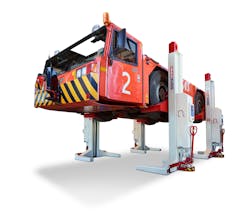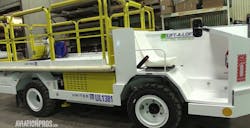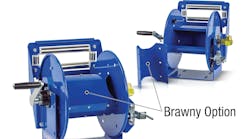Like other industrial vehicles, ground support equipment (GSE) requires regular, routine maintenance to perform at peak efficiency.
However, given the heavier capacities and large diameter tires on certain equipment – like pushback tractors, it can be difficult for GSE mechanics to get under the vehicles to service them.
In the late 1990s, Stertil-Koni introduced its ST 1175 mobile column lift, which offers a capacity of 40,000 pounds per column, explains Tim Kerr, engineering sales support manager at Stertil-Koni.
“The 1175 was specifically designed to lift some of those heavier airport tugs – the ones that would weigh in excess of a 100,000 pounds. And really prior to its introduction, there really wasn't anything out on the market to really lift those vehicles. So, it was a real challenge for a lot of these ground support equipment maintenance facilities,” Kerr says. “Our engineering team got developing, basically took our original version of our mobile column and they just expanded it to this larger column and beefed up all those components to lift up the 40,000 pounds per column.
“And that's really where the 1175 was born.”
With a lifting capacity of 29,000 pounds and the ability to lift vehicles with wheel diameters of 79 to 88 inches, the ST 1130 model – the ST 1175’s “little brother” – was developed 13 years later.
“Those larger vehicles, like the airport tugs, for example, have this very large diameter tire, so that 1130 was really focused on lifting those large tires on those vehicles,” Kerr says.
The ST 1175 and ST 1130 are part of Stertil-Koni’s range of mobile column lifts, which includes five other lifting compacities.
“Obviously, the other versions are a much smaller size than the 1130 and 1175,” Kerr explains. “But functionally, they're all identical across the entire range of mobile columns.”
Meeting GSE Maintenance Needs
The ST 1175 columns can be operated individually, in pairs or as a complete set. In a configuration of four column lifts, the ST 1175 is capable of lifting 160,000 pounds.
While it may not be needed for GSE maintenance, the mobile column lifts are capable of achieving up to 32 columns in a single set, working simultaneously and synchronizing with each other.
Both of the mobile column lift models elevate equipment to 81 inches for additional room to work. They feature numerous safety features including a mechanical locking system, which is always active even when the column is shut off.
“First and foremost is we always pride ourselves here on safety. So that's obviously the number one feature,” Kerr says, noting the mechanical locks are featured every 2 inches for increased safety.
The lifts also offer automatic load protection, an emergency stop on each column and a splash-proof electrical system.
Because the mobile column lifts sync wirelessly, tripping hazards are eliminated because there are no cables on the ground in the area where maintenance personnel are working.
“There’s no cable on the floor. You’re not plugged to the wall. You have completely mobile, versatile columns that can be used anywhere at any time,” Kerr says.
The ST 1130 comes standard with EARTHLIFT technology, which is a regenerative system that collects gravitational energy to recharge the unit’s batteries when the column is traveling down.
“You can get more cycles out of these before you have to plug them back in and charge them,” Kerr says.
ebright Control System
Since being first introduced, Kerr says both the ST 1175 and ST 1130 have undergone facelifts to make the units more sleek and modern. But when it comes to updates, he says none has been more significant than the addition of Stertil-Koni’s ebright Control System as a standard option.
Featuring a 7-inch, color touchscreen, ebright offers users controls with lift data, maintenance notifications and a visual display of programmable lifting heights, among other features.
“It gives you the real-time parameters of the lift – lifting height, the battery status; it'll tell you when the batteries are getting low to get charged. It’s going to give the operator any sort of troubleshooting that may pop up, it'll give an error message on the screen. It can give him maintenance reminders to, perhaps, do a visual inspection or check the oil or whatever it may be on the lift,” Kerr says.
“It's one of the most interactive operating systems you'll see on any lift in the industry.”
While the ebright system provides detailed information and configures mobile columns via a wireless MESH network, it offers users a basic, intuitive interface.
“You have an up button, a down button and an unlock button, just like a traditional lift,” Kerr says. “I know a lot of our users have really taken to the ebright system and just how easy it is and how simple it is and just how intuitive it is to use.”
The ebright system adds safety features to a configuration of mobile column lifts. It uses sensors to constantly monitor that all the columns are synchronized while lifting and lowering equipment.
“For example, if one of these vehicles may be a little heavier in the rear than it is in the front, then the front columns are probably going to be going up a little bit faster than your rear columns,” Kerr explains. “The ebright system recognizes that. It sees that maybe they're getting a little bit out of sync and they'll automatically correct those front columns to slow them down to allow the rear columns to catch up so that you're always keeping that vehicle perfectly level throughout the entire range of motion.”
Accessories for Versatility
While many vehicles are lifted by their tires, some applications in the GSE world may necessitate vehicles being lifted in other locations, such as the frame. To solve this challenge, both the ST 1175 and ST 1130 offer detachable pick-up forks, wheel adapters and other accessories.
“It’s really going to come down to the type of vehicle and where it's recommended lifting points are,” Kerr says, adding company officials work with customers to determine every possible option to lift every vehicle in a fleet so all required maintenance tasks can be performed.
The mobile column lift’s versatility has elicited positive feedback from customers, according to Kerr.
“Traditionally they were using in-ground system lifts to lift some of these vehicles. But sometimes if the tug isn’t able to get onto the lift because it's already broken down somewhere outside or couldn't quite make it, we can bring the lifts to the vehicle rather than bring the vehicle to the lift,” he says.
When selecting a lifting solution for a GSE maintenance shop, Kerr encourages purchasing decision-makers to conduct a survey of their entire fleet and take any vehicle that they plan to lift and maintain into consideration.
“It’s really important to know factors such as the wheelbase, the weight of the vehicle, the type of maintenance that'll be performed on the vehicle. All these different factors will basically lead them to make a decision on what can we buy that will be the most versatile lift to capture the largest percentage of our fleet,” Kerr says.
By having the proper lifting solution in the shop, Kerry says faster turnaround times for maintenance-related tasks can be achieved.
“Time is money,” he says. “So, selecting the proper equipment to get vehicles in and out of that shop is going to save our customers money in the long run and that's going to be a huge benefit to them.”





